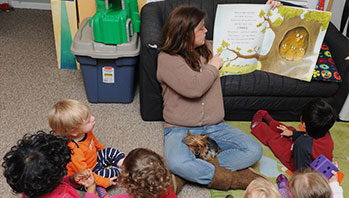- city
- country
- louder
- noisy
- quiet
- softer
- sound
MA Standards:
Literature/RL.PK.MA.1: With prompting and support, ask and answer questions about a story or a poem read aloud.
Literature/RL.PK.MA.9: With prompting and support, make connections between a story or poem and one’s own experiences.
Head Start Outcomes:
Literacy Knowledge/Book Appreciation and Knowledge: Asks and answers questions and makes comments about print materials.
PreK Learning Guidelines:
English Language Arts/Reading and Literature 6: Listen to a wide variety of age appropriate literature read aloud.
English Language Arts/Reading and Literature 10: Engage actively in read-aloud activities by asking questions, offering ideas, predicting or retelling important parts of a story or informational book.
Read Together: City Lullaby #1

© Commonwealth of Massachusetts, Department of Early Education and Care (Jennifer Waddell photographer). All rights reserved.
STEM Key Concepts: Sounds have a source; Different objects make different sounds; Sounds vary in three ways: volume, pitch, and timbre
ELA Focus Skills: Concepts of Print, Making Connections, Speaking and Listening, Vocabulary
Tell children you are going to read City Lullaby by Marilyn Singer, a story about sounds you hear in the city. Ask children to discuss what they know about cities. Ask what sounds they have heard or think they might hear in a busy city.
This story is a very noisy, rhyming, cumulative text that counts down from ten to one and then back to ten as a baby sleeps in a stroller. For the first reading, focus on the noisy sounds of the city. Set a listening focus for children by asking them to imagine the sounds as you read them in the story.
Before You Read
Hold up City Lullaby and ask a volunteer to locate the title and help you point to each word as you read aloud the title and the names of the author and illustrator. Then focus attention on the cover illustration. It may be difficult for children to focus on individual cars, trucks, etc., in the illustration, so you may want to point to and name individual objects. Then ask questions such as,
- Can you describe what you see on the cover?
- Do you think the story takes place in the city or in the country? Why do you think that?
- Have children imagine the sounds being made by the people, the cars, etc., on the cover. Point to a car and ask, What sounds do you think the car makes? Do you think the sound is louder or softer than the great owls in Night in the Country? Why do you think that?
As You Read
- Read the sounds on the left-hand pages loudly, quickly, and with emphasis to help create a noisy atmosphere.
- Point to each word as you read. Have children join you when you read the refrain “in the stroller, Baby’s sleeping.”
- Focus on the right-hand page. Ask children to find the sleeping baby in the illustration. If they have trouble pointing out the baby, you may want to draw a circle around the features with your finger to help them see the sleeping baby.
After You Read
Invite children to describe the sounds they heard in the book; then ask questions such as,
- Are the sounds quiet, soft, or loud?
- Do you think it would be easy to fall asleep in a stroller on a busy city street? Why or why not?
- What sound woke the baby? What kind of sound was it?
- Why do you think the author chose “City Lullaby” as the title of the book?
